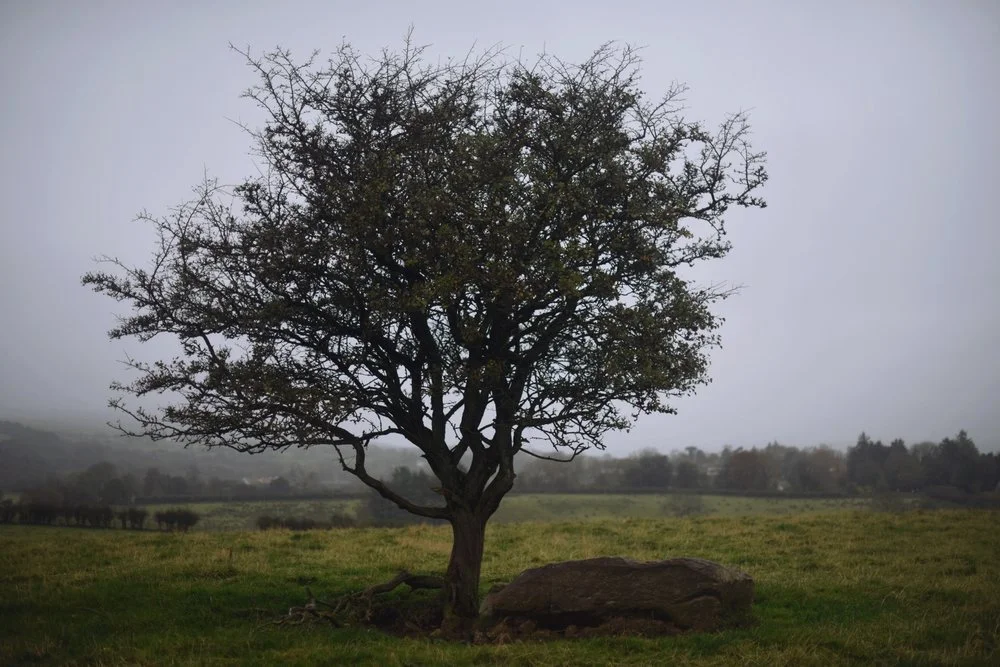[Editorial] Droch Fola (Evil Blood): The Irish Vampire
A billowing silken black cloak envelopes a tall, pale European aristocratic gentleman. His face is framed with a sharp black widow’s peak and as his lips curl into a most distinguished smile, sharpened and elongated canines are revealed. Give this description to any pop culture consumer, and chances are they’ll immediately recognise the owner of these traits as belonging to Dracula. Both horror fans and non-horror fans alike know pretty much everything there is to know about this Carpathian bloodsucker. From its beginnings as a gothic novel, to a story that has been depicted numerous times on television and film, Dracula is the godfather of vampire lore. What many people will probably fail to realise is that Dracula is a story born from an Irish creator. In fact, Ireland has a rich association with vampiric folklore, vampire literature and more recently vampire centric horror films.
Ireland’s history of folklore is a bounteous tradition of supernatural and dark creatures, famously focused on the Aos Sí or the faerie folk. As well as the mischievous and oftentimes sinister intentions of the faerie folk dictating the development of Irish everyday traditions, there are also the tales of the Abhartach and the Dearg Du. Like most countries all over the world, Ireland had its own legends of blood drinking evil deities, with specific lore surrounding these creatures that concerned itself with how to kill them or keep them at bay.
The early legend of the Abhartach has its origins in the north of the country. The lore is that the Abhartach was a cruel creature who possessed the powers of dark magic. After being killed and crudely buried, the creature rose from the grave and was said to be a neamh mairbh, or the walking dead. Every night the Abhartach would escape its burial site, terrorizing the local villagers as it commenced its hunt for fresh blood. The head chieftain Cathain consulted with a holy druid, before killing the horrid bloodsucker with a sword made from the wood of a yew tree. To prevent the Abhartach from being able to rise again, Cathain buried the monster upside down and placed a great stone on the top of its grave. The resting place of the vampiric Abhartach , now named ‘The Giants Grave’ can still be visited today in Derry in the North of Ireland, marked by a large rock and two smaller rocks underneath the sacred tree of Ireland – the Hawthorn.
Another Irish legend centres itself on a vengeful creature of the night with an insatiable hunger for the blood of young men. The Dearg Dur (or sometimes referred to as Dearg Due) is a folktale from County Waterford, that begins with a young woman being sold as a wife to a cruel and abusive chieftain by her greedy father. The chieftain was sadistic and merciless, locking the beautiful woman away only to be used when it pleased him. Lonely and heartbroken, the woman withered away from dehydration and starvation. Her burial was a meagre one and despite burial dictating that to prevent the rising of the dead, stones should be placed on a grave, the Dearg Dur’s grave was left unmarked. While her husband quickly remarried, her remaining family were too engrossed in their newfound riches to mourn her loss. The resurrected corpse of the young woman rose from the grave on the anniversary of her death, spurred on by a desperation for revenge on those who had crossed her in life. Initially sucking the life out of her covetous father, the Dearg Dur went on to discover her husband surrounded by women, and flew into a bloody and violent rage, sucking all of his blood out of his body. The blood made her feel more alive than she had ever felt, but her satisfaction was short-lived. The Dearg Dur used her beauty to lure young men to their deaths, draining them of their blood. She would return to her grave beneath Strongbow’s Tree and would rise every year on the anniversary of her death
HAVE YOU LISTENED TO OUR PODCAST YET?
Dracula’s author, Bram Stoker, was rumoured to have been heavily influenced by the Irish folklore of vampire-like creatures like the Abhartach, as well as Eastern European vampire legends and the life of Vlad of Wallachia. Born in 1847 in Clontarf, Dublin, Bram Stoker began his career in theatre as the theatre critic for the Dublin Evening Mail before relocating to London with his wife and picked up work as theatre manager at the Lyceum Theatre in the west end. After a visit to Whitby, Stoker began writing what would become one of the world’s most infamous works of gothic fiction, Dracula, which would eventually be published in 1897. Despite the popular belief that the whole tale was based on Vlad Dracul of what is now modern day Romania, it is much more probable that Stoker relied heavily on his Irish folklore roots for the basis of the creature, and just used Vlad’s name for his aristocratic bloodthirsty protagonist.
Despite Dracula being the most famous vampire novel of all time, it is actually predated by another Irish vampire tale by more than twenty years. Irish author Sheridan Le Fanu was born in Dublin in 1814 into a literary family. Le Fanu went on to become an influential writer of mystery, supernatural tales and ghost stories. He was the most prominent ghost story writer of his time, central to the Victorian era’s development of the genre and would go on to influence great supernatural writers like M.R James. In 1872, Sheridan Le Fanu wrote his gothic novella Carmilla. Carmilla is a tale of a young woman being preyed upon by the female vampire Carmilla. The story lays the foundations for the female lesbian vampire which would go on to become a trope in vampire depictions both in literature and cinema. Pushing against the Victorian ideals of females at the time, Le Fanu’s portrayal of women was that of empowerment compared to the feebleness of his male characters. The female characters in the novel owned their sexuality and their sensuality, something that can also be noted in the personality traits of Bram Stoker’s characters of Mina and Lucy in Dracula. Carmilla, despite its minuscule popularity in comparison to Stoker’s counterpart novel, has had an overwhelming influence and outlasting legacy in both horror fiction and horror movies such as Dracula’s Daughter (1936) and The Vampire Lovers (1970).
Through the hundreds of Dracula film adaptations and a few of Carmila, the Irish vampire has made its way from page to screen. However, despite the strong Irish connection and folkloric origins of vampire legends, there have been very few domestically Irish produced vampire films. Apart from Irish director Neil Jordan directing the two vampire films Interview With The Vampire (1994) and Byzantium (2012) neither of which were indigenously produced by the Irish film industry nor were they inherently and distinguishably Irish. It wasn’t until very recently in 2021 that the Irish vampire made its cinematic debut. The Boys From County Hell (2021) directed by Chris Baugh is set in a quiet rural community in Fermanagh in which the legendary Abhartach is buried. After accidentally awakening the ancient vampire, road worker Eugene must put aside his tumultuous relationship with his father to stop the vampire from draining the entire town of Six Mile Hill of their blood. The Boys From County Hell is a charming comedy horror that faithfully follows the Abhartach legend, paying homage to the Irish vampire’s folklore roots.
Another vampire centric 2021 release was that of Let The Wrong One In directed by Conor McMahon. Another horror comedy, this entry to the vampire subgenre situates itself in urban inner city Dublin where Matt discovers his older estranged brother Deco has become a vampire. Whilst attempting to figure out whether he should stake Deco or try to save him, Matt must also thwart a gang of female vampires who are hellbent on turning the whole of the city into bloodthirsty creatures of the night. Let The Wrong One In is a comedic but poignant commentary on the effect of the drug problem in Ireland has had on families and society as a whole. Despite not having any particular grounding in the Irish vampire traditions, it is a vampire movie that is very much rooted in Irish society and culture.
Ireland may not be the very first culture that comes to mind when one thinks of vampires and their origins, but from the ancient legends of the walking dead hungry for fresh human blood, to the romantic gothic pages of novels written by Irish authors of aristocratic vampires dripping in sexuality, Ireland is very much the motherland of the vampire.





![[Ghouls Podcast] Maniac (2012) with Zoë Rose Smith and Iona Smith](https://images.squarespace-cdn.com/content/v1/5fe76a518d20536a3fbd7246/1696356006789-NYTG9N3IXCW9ZTIJPLX2/maniac.jpg)
![[Ghouls Podcast] The Last House on the Left (2009) with Zoë Rose Smith and Jerry Sampson](https://images.squarespace-cdn.com/content/v1/5fe76a518d20536a3fbd7246/1687863043713-54DU6B9RC44T2JTAHCBZ/last+house+on+the+left.jpg)
![[Ghouls Podcast] The Bay (2012) with Ariel Powers-Schaub & Amber T](https://images.squarespace-cdn.com/content/v1/5fe76a518d20536a3fbd7246/1684751617262-6K18IE7AO805SFPV0MFZ/The+Bay+website+image.jpg)
![[Ghouls Podcast] Picnic at Hanging Rock (1975) with Zoë Rose Smith & Rebecca McCallum](https://images.squarespace-cdn.com/content/v1/5fe76a518d20536a3fbd7246/1682536446302-I2Y5IP19GUBXGWY0T85V/picnic+at+hanging+rock.jpg)
![[Ghouls Podcast] Psychotic Women in Horror with Zoë Rose Smith & Mary Wild](https://images.squarespace-cdn.com/content/v1/5fe76a518d20536a3fbd7246/1678635495097-X9TXM86VQDWCQXCP9E2L/Copy+of+Copy+of+Copy+of+GHOULS+PODCAST+THE+LOVED+ONES.jpg)
![[Ghouls Podcast] Nekromantik with Zoë Rose Smith & Rebecca McCallum](https://images.squarespace-cdn.com/content/v1/5fe76a518d20536a3fbd7246/1677422649033-Z4HHPKPLUPIDO38MQELK/feb+member+podcast.jpg)
![[Ghouls Podcast] Final Destination 5 & Wrap-up with Ariel Powers-Schaub & Iona Smith](https://images.squarespace-cdn.com/content/v1/5fe76a518d20536a3fbd7246/1672841326335-WER2JXX7WP6PO8JM9WB2/PODCAST+BONUS+2023+%284%29.jpg)
![[Ghouls Podcast] Final Destination 3 & 4 with Ariel Powers-Schaub & Iona Smith](https://images.squarespace-cdn.com/content/v1/5fe76a518d20536a3fbd7246/1672841151148-U152EBCTCOP4MP9VNE70/PODCAST+BONUS+2023+%283%29.jpg)
![[Ghouls Podcast] Final Destination 1 & 2 with Ariel Powers-Schaub & Iona Smith](https://images.squarespace-cdn.com/content/v1/5fe76a518d20536a3fbd7246/1672841181605-5JOOW88EDHGQUXSRHVEF/PODCAST+BONUS+2023+%282%29.jpg)
![[Ghouls Podcast] Henry: Portrait of a Serial Killer (1986)](https://images.squarespace-cdn.com/content/v1/5fe76a518d20536a3fbd7246/1672841247731-65K0JKNC45PJE9VZH5SB/PODCAST+BONUS+2023+%281%29.jpg)
![[Ghouls Podcast] A Serbian Film with Rebecca and Zoë](https://images.squarespace-cdn.com/content/v1/5fe76a518d20536a3fbd7246/1672841382382-RY0U5K7XD4SQSTXL2D14/PODCAST+BONUS+2023.jpg)


![[Editorial] Unravelling Mitzi Peirone’s Braid (2018)](https://images.squarespace-cdn.com/content/v1/5fe76a518d20536a3fbd7246/1628359114427-5V6LFNRNV6SD81PUDQJZ/4.jpg)
![[Editorial] In Her Eyes: Tasya Vos in Possessor (2020)](https://images.squarespace-cdn.com/content/v1/5fe76a518d20536a3fbd7246/1667061747115-NTIJ7V5H2ULIEIF32GD0/Image+1+%285%29.jpg)
![[Editorial] Sara in Creep 2 (2017)](https://images.squarespace-cdn.com/content/v1/5fe76a518d20536a3fbd7246/1646478850646-1LMY555QYGCM1GEXPZYM/27ebc013-d50a-4b5c-ad9c-8f8a9d07dc93.jpg)
![[Editorial] In Her Eyes: Helen Lyle in Candyman (1992)](https://images.squarespace-cdn.com/content/v1/5fe76a518d20536a3fbd7246/1649586854587-DSTKM28SSHB821NEY7AT/image1.jpg)
![[Editorial] Lorraine Warren’s Clairvoyant Gift](https://images.squarespace-cdn.com/content/v1/5fe76a518d20536a3fbd7246/1648576580495-0O40265VK7RN03R515UO/Image+1+%281%29.jpg)
![[Editorial] In Her Eyes: Sara Lowes in Witchfinder General (1968)](https://images.squarespace-cdn.com/content/v1/5fe76a518d20536a3fbd7246/1655655953171-8K41IZ1LXSR2YMKD7DW6/hilary-heath.jpeg)
![[Editorial] The Babadook (2014)](https://images.squarespace-cdn.com/content/v1/5fe76a518d20536a3fbd7246/1651937631847-KR77SQHST1EJO2729G7A/Image+1.jpg)
![[Editorial] Re-assessing The Exorcist: Religion, Abuse, and The Rise of the Feminist Mother.](https://images.squarespace-cdn.com/content/v1/5fe76a518d20536a3fbd7246/1629995626135-T5K61DZVA1WN50K8ULID/image2.jpg)
![[Editorial] Margaret Robinson: Hammer’s Puppeteer](https://images.squarespace-cdn.com/content/v1/5fe76a518d20536a3fbd7246/1630075489815-33JJN9LSGGKSQ68IGJ9H/MV5BMjAxMDcwNDI2Nl5BMl5BanBnXkFtZTcwOTMxODgzMQ%40%40._V1_.jpg)
![[Editorial] Sally Hardesty in The Texas Chainsaw Massacre (1974)](https://images.squarespace-cdn.com/content/v1/5fe76a518d20536a3fbd7246/1637247162929-519YCRBQL6LWXXAS8293/the-texas-chainsaw-final-girl-1626988801.jpeg)























![[Editorial] 10 Films & Events to Catch at Soho Horror Film Fest 2023](https://images.squarespace-cdn.com/content/v1/5fe76a518d20536a3fbd7246/1700819417135-299R7L4P0B676AD3RO1X/Screenshot+2023-11-24+at+09.41.52.png)
![[Editorial] 9 Horror Nintendo Switch Games To Play](https://images.squarespace-cdn.com/content/v1/5fe76a518d20536a3fbd7246/1697214470057-3XZXX8N4LYIMDFWS6Z3P/Screenshot+2023-10-13+at+17.20.13.png)
![[Mother of Fears] Mothering in Silence in A Quiet Place (2018)](https://images.squarespace-cdn.com/content/v1/5fe76a518d20536a3fbd7246/1696445921315-HZJ2DZYQIH6VVWXBO2YL/Screenshot+2023-10-04+at+19.52.29.png)
![[Editorial] 5 Female Focused Horror Book Recommendations](https://images.squarespace-cdn.com/content/v1/5fe76a518d20536a3fbd7246/1696441981361-52EQCTJ7AT2QF1927GM7/919xtm6d3fL._AC_UF894%2C1000_QL80_.jpg)
![[Editorial] 9 Best Slashers Released Within 10 Years of Scream (1996)](https://images.squarespace-cdn.com/content/v1/5fe76a518d20536a3fbd7246/1695478839037-LOFHGVM3H6BMSZW7G83M/Screenshot+2023-09-23+at+15.15.11.png)
![[Mother of Fears] Mother Vs. Monster in Silent Hill (2006)](https://images.squarespace-cdn.com/content/v1/5fe76a518d20536a3fbd7246/1695485781119-H6GNP0G3J2TLPAOIABV7/Screenshot+2023-09-23+at+17.11.56.png)
![[Editorial] 9 Terrifying Cerebral Visions in Horror Movies](https://images.squarespace-cdn.com/content/v1/5fe76a518d20536a3fbd7246/1693509801235-X23OL50T1DVGECH0ZJK2/MV5BMjQ0MTg2MjQ4MV5BMl5BanBnXkFtZTgwMTU3NDgxMTI%40._V1_.jpg)
![[Mother of Fears] I Don’t Wanna Be Buried in a Pet Sematary (1989) and (2019)](https://images.squarespace-cdn.com/content/v1/5fe76a518d20536a3fbd7246/1691328766069-QFNAVJOMFZVZ5CLU1RWM/Screenshot+2023-08-06+at+14.23.13.png)
![[Mother of Fears] How I Love to Love Nadine in The Stand (2020)](https://images.squarespace-cdn.com/content/v1/5fe76a518d20536a3fbd7246/1690213172707-TKM9MZXK02EVCIX30M1V/Screenshot+2023-07-24+at+16.29.11.png)
![[Editorial] 11 Best Werewolf Transformations in Horror Films](https://images.squarespace-cdn.com/content/v1/5fe76a518d20536a3fbd7246/1689240234098-HUPQC6L57AAHFJNT8FTE/Screenshot+2023-07-13+at+10.09.13.png)
